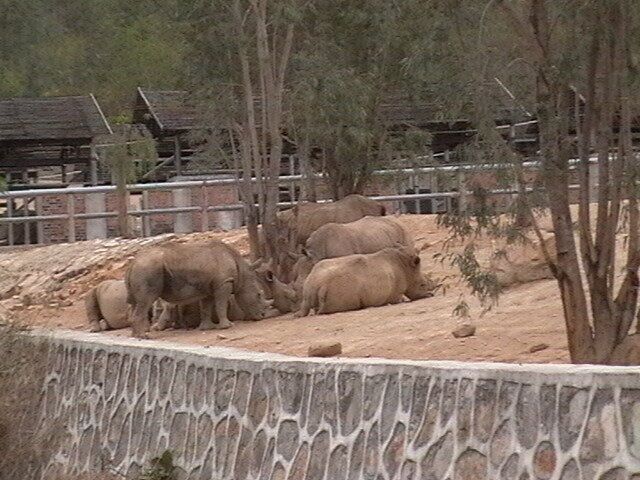In 2010, South Africa reported losses of 333 of its rhinos to poachers. That's almost one rhino per day.
In 2011 that rate has increased, with 280 rhinos poached by late August, the majority from the Kruger National Park. By the end of the year the death toll for 2011 could be as many as 500.
In 2007, only 17 rhinos were reported to have been killed in this way in South Africa.
Poaching is now threatening remaining rhino populations across their range, from Kenya and Zimbabwe to India and Nepal.
So what's going on? And why have the British Authorities become involved?
Rhino horn has been prized as a component of Traditional Chinese Medicine for thousands of years. Products containing rhino horn have been used to treat a variety of disorders including headaches, rheumatism, gout, fevers and convulsions. While evidence for the efficacy of rhino horn, which is largely composed of keratin (much like your fingernails), is scant, there are many who believe in its claimed properties and will pay a high price to get hold of it.
In the 1970s, diminishing rhino populations that had been devastated by decades of trophy hunting and exploitation were given international protection from the impacts of trade by the Convention on International Trade in Endangered Species (CITES). Internal trade in rhino horn was banned in China in 1993, and rhino horn was removed from the official Traditional Medicine Pharmacopeia.
However, claims (that have never been substantiated) from Vietnam in 2006 that a high ranking Government official used rhino horn to cure his cancer, coupled with rising wealth in the traditional medicine markets of China and Vietnam, have caused demand for rhino horn to soar, and prices on the streets to reach unprecedented levels. Some reports suggest powdered rhino horn can fetch as much as £50,000 per kg in Vietnam, making it more expensive, gram for gram, than cocaine, heroin, or gold.
This has given criminal elements a huge incentive to target rhino horn, with devastating consequences for remaining rhinos. Poachers are using increasingly sophisticated methods to obtain the valuable product, including helicopters, veterinary drugs, and modern weaponry, outmatching the resources available to the enforcement authorities charged with protecting the rhinos. The poachers show no concern for the rhinos' welfare: nursing mothers are targeted and calves left to grieve and starve (unless they are lucky enough to be rescued in time), and some rhinos whose horns have been hacked off have even recovered from the sedatives used to restrain them only to wander for hours or days before bleeding to death from their wounds, or suffering an agonising death from infection. High ranking officials from governments and enforcement agencies are sometimes reportedly involved, taking backhanders to give the poachers vital information, or to facilitate the transport of horn across borders.
In recent years Vietnamese and other nationals have been applying for permits to 'hunt' white rhinos in South Africa, in order to export the horns to Vietnam, where they are thought to be entering the illegal traditional medicine trade. South Africa has also exported a large number (more than 200 between 2006 and 2009) of live rhinos, principally to China; there is concern that the Chinese companies involved are planning to use these animals as breeding stock in order to set up commercial 'horn harvesting' facilities to supply the medicine trade, and are putting pressure on the Chinese authorities to review the internal trade ban.

There is concern that Chinese companies that have imported rhinos such as these from South Africa, are keeping them in unsuitable conditions, and are planning to 'farm' them for their valuable horns.
It's not only live rhinos that are being targeted. With such riches to be gained through the supply of horn to the Far East, antiques made from rhino horn, and rhino horn trophies, have also attracted interest. In 2010, six UK auction houses sold antique rhino horns for an accumulated value of over US$2 million, way above their estimated antique value. The British authorities responded in September 2010 by placing severe restrictions on the export of antique rhino horn objects and trophies, amid fears that the items were being exported for grinding down and sale as powdered horn in the Far East, fuelling the trade. Other countries are currently being urged to take similar action.
Research by Humane Society International has revealed that since April 2008 a minimum of 41 rhino horns have been stolen from private premises in South Africa, Europe and the United States. Targets have included museums, private stockpiles, and even zoo mortuaries following the deaths of rhinos among their collections. 2011 in particular has seen at least 20 thefts from museums in a number of European countries including France, Portugal, The Netherlands, Belgium, Germany and the UK. As a result some museums have taken their rhino exhibits off display, or have taken the precaution of replacing real horns with fake ones. A European organised crime syndicate is thought to be behind many of these thefts.
Some Southern African countries hold considerable stockpiles of rhino horns collected from animals who have died, or seized from poachers or illegal traders. There is concern that some of these countries may consider applying to CITES for dispensation to sell their stockpiles to East Asian countries in order to generate income (ostensibly for conservation projects) and in an attempt to 'flood' the traditional medicine market with legal product. However, with demand and prices currently at such high levels, such a move may serve only to stimulate even more demand and lend legitimacy to the trade, further incentivising the poachers.
If rhino populations are to be saved from extinction at the hands of poachers, a range of actions are urgently required. Remaining rhino populations need better protection. More and better trained and equipped park staff are needed. Border security needs to be tightened up. Loopholes in national and international regulations need to be closed to prevent poachers posing as trophy hunters and exporting 'trophy' horns for sale into the lucrative traditional medicine markets. Exports of live rhinos from South African ranches to China, Vietnam and other Asian destinations need to be stopped. Horn stockpiles that are currently in private hands need to be managed by governments in a transparent way, and preferably destroyed.
The Democratic Alliance, South Africa's official opposition party, recently called for a moratorium on trophy hunting of rhinos to be imposed until improved controls can be put in place. Press reports suggest that Environment Minister Edna Molewa is considering that option.
Perhaps most importantly, every effort is needed to reduce demand for rhino horn among users of traditional medicines in China, Vietnam and elsewhere, through engagement of the Traditional Medicine Community, education, awareness-raising and rigorous law enforcement.
The British authorities have taken the proverbial rhino bull by its prized horns at recent meetings of the Convention on International Trade in Endangered Species, by proposing the formation of a Working Group comprising major range and consumer countries and other experts. The group will be mandated to explore protection and enforcement measures, public education and demand-reduction efforts. In addition, the UK will chair a meeting of the Coalition Against Wildlife Trafficking (CAWT) in South Africa at the end of September, to explore rhino enforcement and protection issues. Humane Society International will be represented at both forums.
The British authorities are to be congratulated for their forthright stance. The traditional medicine trade concerns highly sensitive cultural issues. But if we are to avoid turning these ancient and noble animals into nothing more than artefacts in museums and curiosities in zoos, the global community must put cultural sensitivities aside and work together to secure the future of wild rhinos.
